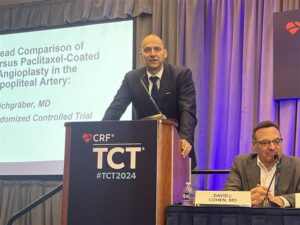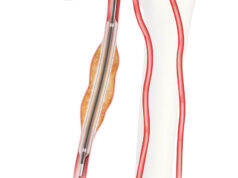
Data from the prospective, multicentre, investigator-initiated SIRONA randomised clinical trial demonstrated MagicTouch (Concept Medical) sirolimus-coated balloons to be noninferior compared to paclitaxel-coated balloons with regards to the primary safety and efficacy endpoints in patients with femoropopliteal artery disease. Findings were reported today at TCT 2024 (27–30 October, Washington, DC, USA).
Researchers aimed to determine if sirolimus-coated balloon angioplasty is noninferior to paclitaxel-coated balloon angioplasty. From April 2021 to September 2022, a total of 482 participants with Rutherford category 2–4 femoropopliteal artery disease were enrolled at 25 clinical sites in Germany and Austria. Patients were randomised 1:1 to receive angioplasty with either a sirolimus-coated balloon or a paclitaxel-coated balloon. Patient characteristics were similar between both groups.
The mean lesion length was 84±61 mm. A total of 34% of the lesions were totally occluded and 29% were calcified according to Peripheral Arterial Calcium Scoring System (PACSS) grade four. Bailout stents were implanted in 22.8% of the sirolimus group and 20.3% of the paclitaxel group lesions (2.5% (95% confidence interval [CI]: -4.9% to 9.8%).
The rate of the primary efficacy endpoint of primary patency at 12 months was 73.8% in the sirolimus drug-coated ballon (DCB) group compared with 75.0% in the paclitaxel DCB group (-1.2% (-9.7% to 7.4%, p=0.022, non-inferiority). The rate of the composite primary safety outcome at 12 months of clinically driven target vessel revascularisation (cdTVR), major amputation, or death was 9.4% in the sirolimus DCB versus 7.3% in the paclitaxel DCB (2.1% (95% CI: -3.2% to 7.5%, p=0.003, non-inferiority). Functional outcomes were similar between the two groups.
“This head-to-head comparison of sirolimus-coated balloons with paclitaxel-coated balloons during angioplasty of the femoropopliteal artery shows comparable results between the two study groups,” said Ulf Teichgräber (University Hospital Jena, Jena, Germany). “Understanding the safety and efficacy of these two types of balloons, especially compared to one another, can help provide the best patient care possible.”












